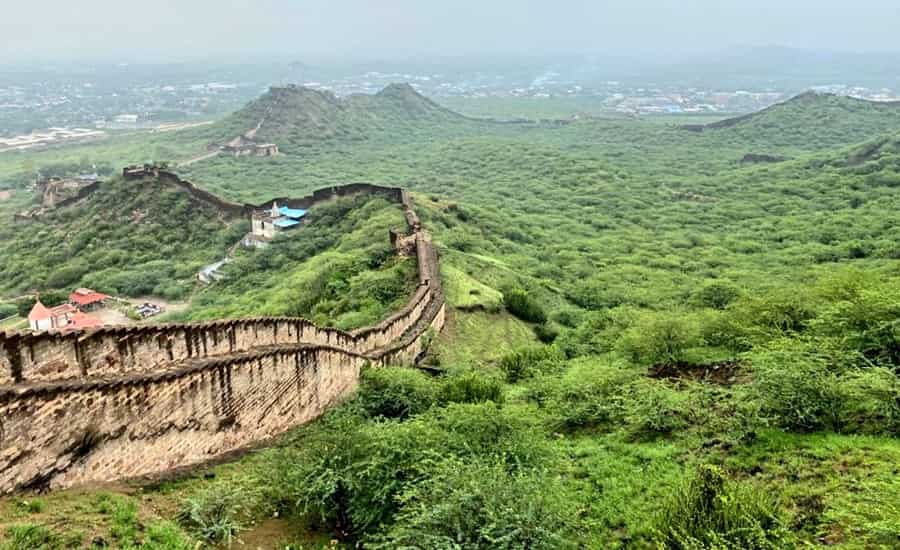Bhujia Fort, nestled on Bhujia Hill in the outskirts of Bhuj town, stands as a testament to the rich historical tapestry of Kutch, Gujarat, India. This comprehensive travel guide aims to provide detailed insights into the fort’s history, architecture, tourist attractions, activities, and practical information for an enriching exploration.
- Address: Bhujia Fort Road, Bhujio Dungar, Bhuj – 370020
- Opening Hours: Bhujia Fort is open to visitors from 6 AM to 6 PM. However, special permissions may be required for entry during restricted periods.
- Entry Fee: Free
- Time Required: 2-3 hours

History of Bhujia Fort
Construction and Purpose
Bhujia Fort traces its origins to the visionary leadership of Jadeja Chiefs. The foundation was laid by Rao Godji I (1715–1718), the ruler of the Kingdom of Kutch. Initially conceived as a defensive structure for the city, the fort’s construction began under Rao Godji I but saw significant progress during the rule of his son, Deshalji I (1718–1741). The strategic location atop Bhujia Hill fortified the capital, Bhuj, witnessing six major battles between 1700 and 1800 AD.
- Suggested Tour: Full Day Sightseeing Tour of Bhuj
Significant Battles
The fort played a crucial role in the defense of Kutch against external invasions. Notably, during the early reign of Deshalji I, Sher Buland Khan, the Mughal Viceroy of Gujarat, invaded Kutch. The fort’s gate was ingeniously opened by a group of Naga Bawas, facilitating a turning point in the battle. Post-independence, the fort came under British control in 1819 and later housed the Indian Army until 2001.
Architecture of Bhujia Fort
Layout and Features
Bhujia Fort, perched on Bhujia Hill, boasts a layout that combines strategic military elements with architectural finesse. Although partially in ruins, the fort displays remnants of its historical grandeur. The Gujarat government is actively overseeing restoration efforts to preserve this cultural heritage. To enter the fort, visitors must pass through two major gates, leading to an irregularly arranged cluster of buildings with a weakened parapet wall at the top.
- Also Read: Top 13 Most Popular Forts in Gujarat
Bhujia Hill and Summit Views
Approximately 200 steps lead to the fort’s summit, providing nature enthusiasts and adventure seekers with a rewarding trek. The panoramic views from the top, especially during sunrise and sunset, offer a captivating sight of Bhuj town and its surroundings.
Tourist Attractions at Bhujia Fort
Bhujanga Nag Temple
The fort houses the Bhujanga Nag Temple, dedicated to the snake god Bhujanga. Constructed during the fortification period (1718-1741), the temple holds historical significance. Deshal Ji I, after a victorious war against Sher Khan, built a chhatri over the temple in 1723. The Nag Panchami fair, celebrated annually in the month of Shravan, honors Bhujang Nag, and the temple becomes a focal point of religious and cultural activities.
Tourist Activities
Trekking Trails
Bhujiya Hill offers trekking enthusiasts an opportunity to explore its surroundings through various trekking trails. The smallish hill provides a satisfying trek to its summit. Nature lovers can indulge in a physical adventure while enjoying the breathtaking beauty of the landscape.
Fort Exploration
While civilian access to Bhujia Fort is restricted, special permissions are granted during Nag Panchami. Visitors can explore the fort’s premises, gaining insights into its historical significance and architectural features.
Nag Panchami Fair
The Nag Panchami fair held at Bhujiya Hill is a vibrant celebration that attracts locals and tourists alike. The fair, paying homage to Bhujang Nag, includes religious ceremonies, cultural performances, and a lively atmosphere.
Breathtaking Views
Walking around the fort area provides visitors with stunning views of Bhuj and its surroundings. The climb up the long flight of steep stairs is rewarded with a mesmerizing panorama, making it an ideal spot for photography enthusiasts.
Best Time to Visit
The recommended time to explore Bhujia Fort is from March to July, offering favorable weather conditions for outdoor activities and trekking.
How to Reach Bhujia Fort
By Road
Bhuj is well-connected by road to major cities in Gujarat. Buses are available from various locations, providing a convenient mode of transportation.
By Train
Bhuj Railway Station serves as the nearest railway station, facilitating easy access to the town. Travelers can opt for trains connecting Bhuj to other major cities.
By Air
Bhuj has a domestic airport, ensuring air connectivity. However, Sardar Vallabhai Patel International Airport in Ahmedabad is the primary international airport in the region.
Do’s & Dont’s
Do’s
- Admire and respect the historical and religious significance of Bhujia Fort.
- Follow safety guidelines during the trek and exploration.
Dont’s
- Do not enter restricted zones without proper permissions.
- Refrain from consuming liquor within the fort premises.
Conclusion
Bhujia Fort stands as a captivating blend of history, architecture, and natural beauty. Exploring this ancient hill fort offers travelers a journey through time, providing a deeper understanding of Kutch’s cultural and historical heritage. From the strategic significance of its construction to the vibrant festivities during Nag Panchami, Bhujia Fort beckons adventure seekers, history enthusiasts, and spiritual seekers alike. Plan your visit to Bhujia Fort for an immersive experience that transcends the boundaries of time and unveils the charm of this historical gem in Gujarat.
Popular Tour Packages
